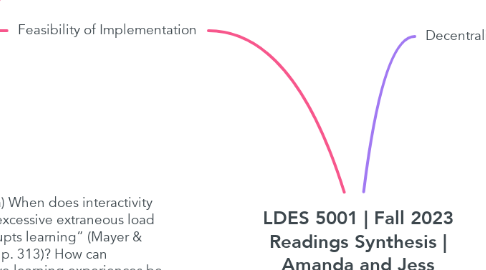LDES 5001 | Fall 2023 Readings Synthesis | Amanda and Jess
by Yianna Vovides


1. Course Delivery Modes & Meeting the Needs of In-Person/Remote Learners
1.1. (Melanie) I found just through my participation that given the technology limitations, it is easiest for the learners to be groups in virtual-only or in-person only groups but this limits the level of interaction possible for all students. I would be interested in more articles or research on hybrid student collaboration and how to best facilitate discussions between in-person and virtual groups.
1.2. (Melanie) I found it interesting that students having a sense of ownership over the learning environment had such a positive effect on learning. In the bisynchronous environment, where is this space for students to flex their new learning muscles and collaborate with each other?
1.3. (Milos) Given the challenge of effectively engaging both remote and in-person learners in ALCs, especially in today's educational landscape with a mix of in-person and remote instruction, what strategies can educators employ to strike a balance and ensure that all students, regardless of their physical presence, have an equitable and engaging learning experience?
1.4. (Gladys ) How can constructivist learning through instruction be fostered? and how do we clearly depict to educators conditions under which interactivity promotes knowledge construction?
2. Decentralization of the Professor
2.1. (Milos) In traditional classrooms, there's often a clear divide with the instructor's designated area at the front. However, in ALCs, this hierarchy blurs, fostering a more collaborative and inclusive learning environment. It raises questions about how this shift in physical space can influence the instructor's teaching style and enhance students' engagement.
2.2. (Jessie) However, this shift towards learner-focused learning raises an important question about the critical tools that students need to be able to take charge of their own learning. How can classroom infrastructures and technologies enable more student agency? And subsequently, what kind of mindset should instructors aim to instill in their students in order for them to direct their learning?
3. Effectiveness of New Technologies for Learners
3.1. (Amanda) When does interactivity “create excessive extraneous load that disrupts learning” (Mayer & Moreno, p. 313)? How can interactive learning experiences be overwhelming, distracting, or miss their objective?
3.2. (Andrés) Are we creating learning spaces based on emerging learning technologies or based on students’ needs that can be addressed by implementing these technologies in their learning spaces?
3.2.1. (Andrés) How much of these technologies contribute to extraneous processing?
